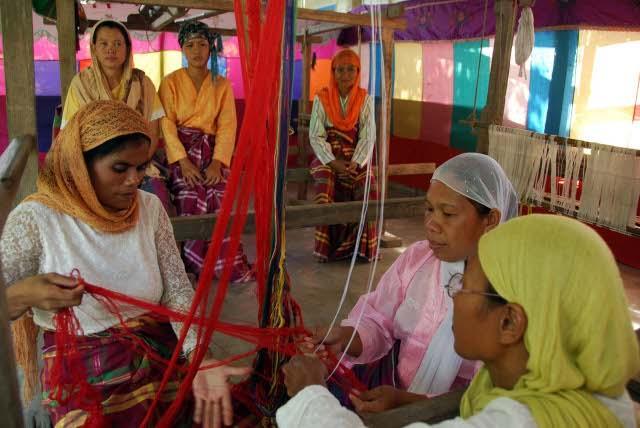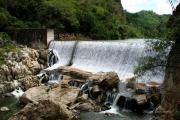
Maranao’s Dagmay and Langsay Making
Tugaya is a lakeshore community in Lanao Del Sur inhabited by Maranao craftsmen and artisans of various pursuits. They are specializes in some forms of arts or crafts that are part of traditional Maranao culture: back-strap loom weaving, tapestry weaving, and other kinds of handmade textile manufacture; foundry casting of various forms of brass or bronze vessels, instruments, and decorative items; wood-carving and mother-of-pearl inlay work; metalwork and silver- and gold-smiting – all of which utilize the traditional Maranao form of decoration.
Maranao art is very distinctive. From this community come the artisans called upon to decorate major forms of architecture in the traditional manner. Their textile weaving includes the traditional Southeast Asian back-strap loom weaving, utilizing native decorative motifs. Laborious, expert needle-weaving produces the complex "langkit" panels which are incorporated into the traditional Maranao garment, the "malong landap". Foundries employ the cire perdue or "lost wax" method to produce various types of bronze or brass products which follow traditional forms, such as the "gador" (a pair of ornate brass urns). Metal forging uses the traditional Southeast Asian double-bellows forge, and employs traditional tools. Other forms of metalwork include hand shaping and pounding of metal sheets, a laborious method which transforms flat metal sheets into sturdy, solid metal Maranao kulintang ensemble gong instruments, including "gandingan" and "agong". Woodworking includes manufacture of decorative objects, ornate furniture such as the traditional storage chest "baul", musical instruments such as the large drum "dadabuan", and ceremonial 12-foot-tall Maranao drums (such as were used for the adhan in the 1800s). Carved and painted wood products also feature the distinctive okir decorative motifs.
Additional, Maranaos are the largest manufacturers of brassware in the Philippines. The brass artisans of Tuguya are utilizing scraps recovered from the bomb casings and ammunition shells of the Second World War. These are melted in a crude crucible made of a mixture of clay and charcoal and poured into a clay-mould between which is a wax designed. In other words, the manufacturer of brassware utilizes a technique called the "lost wax process." The designs (okir) on the brassware are basically the same as those on carved wood. The carver’s tools are few and very crude when compared with modern carving tools. The basic ones are the curved knife (nawi), the chisel (panasang), the axe (patok), and the charcoal of pencil for lining. For coloring, if this is desired (as is usual for the musical instrument rack, the langkogan or kulintang), plant dyes are used, although chemical dyes are becoming popular nowadays. Maranao man-made mats and cloth are decorated in flamboyant colors. They also weave bags, centerpieces, placemats, and unique neckties.
Maranao Art
The pairaan is a rich sample of Maranaw art. It not only illustrates the dichotomy of artistic inclinations according to sexes but at the same time blends these two dichotomous inclinations (i.e. the geometric-angular designs of women as against the curvilinear-smooth designs of men) into one coherent whole. And, inasmuch as the fern like covered is interpreted as symbolic of the "tree-of-life" in heaven, there is in the pairaan also an indication of the interconnectedness of the Maranaw art with mythical and other folkloric beliefs.
Trivia:
The carving of wood, horn, and ivory, like brass manufacture, is a man's work. Yet, while almost every male in Lanao has some knowledge of this art, only those who has undergone a certain ritual eventually engage in it. The ritual is performed in honor of Tominaman sa Rogon, the mythical patron of art, and this involves a blood-letting ceremony in which a chicken is butchered and its blood sprinkled on the hands and tools of the would-be carver.










